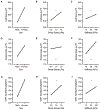Sex-Specific Response to Combinations of Shear Stress and Substrate Stiffness by Endothelial Cells In Vitro
- PMID: 34142471
- PMCID: PMC8458248
- DOI: 10.1002/adhm.202100735
Sex-Specific Response to Combinations of Shear Stress and Substrate Stiffness by Endothelial Cells In Vitro
Abstract
By using a full factorial design of experiment, the combinatorial effects of biological sex, shear stress, and substrate stiffness on human umbilical vein endothelial cell (HUVEC) spreading and Yes-associated protein 1 (YAP1) activity are able to be efficiently evaluated. Within the range of shear stress (0.5-1.5 Pa) and substrate stiffness (10-100 kPa), male HUVECs are smaller than female HUVECs. Only with sufficient mechanical stimulation do they spread to a similar size. More importantly, YAP1 nuclear localization in female HUVECs is invariant to mechanical stimulation within the range of tested conditions whereas for male HUVECs it increases nonlinearly with increasing shear stress and substrate stiffness. The sex-specific response of HUVECs to combinations of shear stress and substrate stiffness reinforces the need to include sex as a biological variable and multiple mechanical stimuli in experiments, informs the design of precision biomaterials, and offers insight for understanding cardiovascular disease sexual dimorphisms. Moreover, here it is illustrated that different complex mechanical microenvironments can lead to sex-specific phenotypes and sex invariant phenotypes in cultured endothelial cells.
Keywords: cell-material interaction; mechanobiology; precision medicine; sex differences.
© 2021 Wiley-VCH GmbH.
Conflict of interest statement
Conflict of Interest
The authors declare no conflict of interest.
Figures









Similar articles
-
Does cellular sex matter? Dimorphic transcriptional differences between female and male endothelial cells.Atherosclerosis. 2015 May;240(1):61-72. doi: 10.1016/j.atherosclerosis.2015.02.018. Epub 2015 Feb 16. Atherosclerosis. 2015. PMID: 25756910
-
Longitudinal shear stress response in human endothelial cells to atheroprone and atheroprotective conditions.Proc Natl Acad Sci U S A. 2021 Jan 26;118(4):e2023236118. doi: 10.1073/pnas.2023236118. Proc Natl Acad Sci U S A. 2021. PMID: 33468662 Free PMC article.
-
Collective influence of substrate chemistry with physiological fluid shear stress on human umbilical vein endothelial cells.Cell Biol Int. 2021 Sep;45(9):1926-1934. doi: 10.1002/cbin.11632. Epub 2021 Jun 9. Cell Biol Int. 2021. PMID: 34009727
-
Ginkgolide B inhibits platelet and monocyte adhesion in TNFα-treated HUVECs under laminar shear stress.BMC Complement Altern Med. 2018 Jul 20;18(1):220. doi: 10.1186/s12906-018-2284-8. BMC Complement Altern Med. 2018. PMID: 30029641 Free PMC article.
-
Racial differences in the responses to shear stress in human umbilical vein endothelial cells.Vasc Health Risk Manag. 2011;7:425-31. doi: 10.2147/VHRM.S22435. Epub 2011 Jul 11. Vasc Health Risk Manag. 2011. PMID: 21796257 Free PMC article.
Cited by
-
Inflammatory serum factors from aortic valve stenosis patients modulate sex differences in valvular myofibroblast activation and osteoblast-like differentiation.Biomater Sci. 2022 Nov 8;10(22):6341-6353. doi: 10.1039/d2bm00844k. Biomater Sci. 2022. PMID: 36226463 Free PMC article.
-
Y chromosome-linked UTY modulates sex differences in valvular fibroblast methylation in response to nanoscale extracellular matrix cues.Sci Adv. 2025 Mar 14;11(11):eads5717. doi: 10.1126/sciadv.ads5717. Epub 2025 Mar 12. Sci Adv. 2025. PMID: 40073144 Free PMC article.
-
Pressure Points: Endothelial Responses to Shear Stress and Pressure in Health and Pulmonary Arterial Hypertension.bioRxiv [Preprint]. 2025 Jul 31:2025.07.28.666693. doi: 10.1101/2025.07.28.666693. bioRxiv. 2025. PMID: 40766446 Free PMC article. Preprint.
-
Endothelial cell (EC)-specific Ctgf/Ccn2 expression increases EC reprogramming and atherosclerosis.Matrix Biol. 2025 Apr;136:102-110. doi: 10.1016/j.matbio.2025.01.003. Epub 2025 Jan 14. Matrix Biol. 2025. PMID: 39818254
-
Advancements in hydrogel design for articular cartilage regeneration: A comprehensive review.Bioact Mater. 2024 Sep 14;43:1-31. doi: 10.1016/j.bioactmat.2024.09.005. eCollection 2025 Jan. Bioact Mater. 2024. PMID: 39318636 Free PMC article. Review.
References
-
- James BD, Allen JB, ACS Biomater. Sci. Eng 2018, 4, 3818. - PubMed
-
- Nagelkerke A, Bussink J, Rowan AE, Span PN, Semin. Cancer Biol 2015, 35, 62. - PubMed
-
- Chou DB, Frismantas V, Milton Y, David R, Pop-Damkov P, Ferguson D, Macdonald A, Vargel Bölükbaşı Ö, Joyce CE, Moreira Teixeira LS, Rech A, Jiang A, Calamari E, Jalili-Firoozinezhad S, Furlong BA, O’sullivan LR, Ng CF, Choe Y, Marquez S, Myers KC, Weinberg OK, Hasserjian RP, Novak R, Levy O, Prantil-Baun R, Novina CD, Shimamura A, Ewart L, Ingber DE, Nat. Biomed. Eng 2020, 4, 394. - PMC - PubMed
Publication types
MeSH terms
Grants and funding
LinkOut - more resources
Full Text Sources
Research Materials

